Gene regulation in Streptococcus pneumoniae - RePub - Erasmus ...
Gene regulation in Streptococcus pneumoniae - RePub - Erasmus ...
Gene regulation in Streptococcus pneumoniae - RePub - Erasmus ...
You also want an ePaper? Increase the reach of your titles
YUMPU automatically turns print PDFs into web optimized ePapers that Google loves.
Chapter 3<br />
Results<br />
Transcriptional analyses of ΔpsaR <strong>in</strong> D39 and TIGR4<br />
70<br />
70<br />
By means of microarrays analysis, we assessed which genes were affected <strong>in</strong><br />
expression due to the mutation of psaR <strong>in</strong> two genetic backgrounds, i.e., D39 and TIGR4. To<br />
this end, transcriptional profiles of wild-type stra<strong>in</strong>s were compared to their isogenic ΔpsaR<br />
stra<strong>in</strong>s. These bacteria were grown <strong>in</strong> chemically def<strong>in</strong>ed medium (CDM) and harvested at<br />
mid-log growth phase. In all experiments, the psaR mutant stra<strong>in</strong>s grew like wild-type. The<br />
concentration of Mn 2+ <strong>in</strong> CDM is 180 μM, which is sufficient for PsaR-<strong>regulation</strong> (see<br />
reference (31), where 50 μM was used). For comprehensibility, loci of D39 are referred to by<br />
the TIGR4 gene identifiers (<strong>in</strong> Table 3 both annotations are given). Comparison of<br />
transcriptional profiles of D39 and TIGR4 wild-type with their ∆psaR counterparts revealed<br />
19 differentially expressed genes <strong>in</strong> TIGR4∆psaR, and 37 <strong>in</strong> D39∆psaR. Of these, five genes<br />
were upregulated <strong>in</strong> both TIGR4 and D39 psaR-mutants, while only psaR itself was<br />
downregulated <strong>in</strong> both stra<strong>in</strong>s (Fig. 1).<br />
The genes that were differentially expressed <strong>in</strong> both serotypes were all upregulated <strong>in</strong><br />
the psaR-mutant confirm<strong>in</strong>g the general role of PsaR as a transcriptional repressor (28, 32).<br />
Among those were the previously described targets, the psa operon (sp1648-sp1650), pcpA<br />
(sp2136), and prtA (sp0614). In addition, sp1637, encod<strong>in</strong>g a hypothetical prote<strong>in</strong> of unknown<br />
function, was found to be upregulated <strong>in</strong> the psaR mutants of both stra<strong>in</strong>s (Table 3).<br />
Four genes were found to be repressed by PsaR <strong>in</strong> D39 (i.e., upregulated <strong>in</strong><br />
D39∆psaR) only: sp0303, encod<strong>in</strong>g 6-phospho-beta-glucosidase, sp0306, encod<strong>in</strong>g a putative<br />
transcriptional regulator, and two genes of a putative operon encod<strong>in</strong>g a cellulose-specific<br />
phosphotransferase system (PTS) (sp0308 and sp0310).<br />
Twenty-seven genes were downregulated <strong>in</strong> D39ΔpsaR. This set of genes conta<strong>in</strong>ed<br />
sp0112, predicted to encode an am<strong>in</strong>o acid substrate-b<strong>in</strong>d<strong>in</strong>g prote<strong>in</strong>, the transcriptional<br />
regulator mutR (sp0141), a putative bacterioc<strong>in</strong> system (sp0142-sp0146), the blp two-<br />
component system (TCS13; sp0526-sp0527), the gene encod<strong>in</strong>g response regulator CiaR<br />
(sp0798), and glyA (sp1024) encod<strong>in</strong>g ser<strong>in</strong>e hydroxymethyltransferase. The full set of<br />
differentially expressed genes <strong>in</strong> D39 is listed <strong>in</strong> Table 3.<br />
In addition to the common gene targets, n<strong>in</strong>e genes were specifically upregulated <strong>in</strong><br />
the psaR-mutant <strong>in</strong> TIGR4 (Fig. 1). These <strong>in</strong>cluded the rlrA pathogenicity islet (sp0461-<br />
sp0468) as reported previously (28), sp1636 (encod<strong>in</strong>g an Rf2 family prote<strong>in</strong>), and two

















